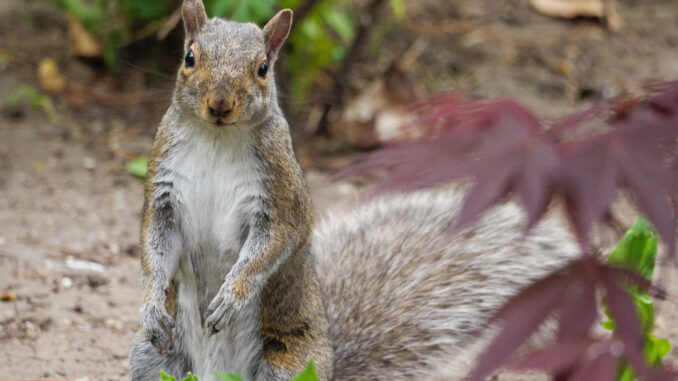
In the flurry of departure preparations, you can plan a colourful return next year by planting spring bulbs. But give some thought to protecting your investment from the interest of garden critters. You may be headed for sunny days, but the cold wind still blows at home.
Protecting your spring bulb investment
The autumn task of planting spring bulbs is an investment in next year’s colourful landscape. After perusing catalogues and websites, purchasing your selection of spring-blooming bulbs and settling them into tidy clusters among shrubs and perennial borders – that is the time to sit back and consider the job well done.
But sometimes, the following morning reveals a scene less like a neat garden bed and more like a ravaged field. Something has been digging up bulbs and feasting on your carefully deposited investment. If squirrels are among the frequent wildlife visitors to your garden, well then, you probably know what did it. To be fair, squirrels are wild animals following instinctual commands – that is to say, a squirrel just must do what comes naturally. Unfortunately, this has happened at your expense and disappointment. Blind rage will offer you no satisfaction. Better to understand why squirrels dig and learn some techniques to avoid those triggers.
Autumn is the harvesting season for squirrels, and they’re busy gathering all of the nuts that they can find. Any solid round plant object is considered a fair addition to their diet. The gathering instinct is highly competitive. A squirrel is eager to collect as much food as possible from woody, nut-producing plants. They will observe another critter at work and rob the cached food. That is a primary lesson for gardeners. Never plant bulbs when a squirrel is in the garden to observe the location of your buried bulb stash.
Spraying animal repellants or sprinkling hot red pepper flakes is only briefly effective, if at all. The smartest way to keep critters from digging up your bulb investment is to carefully disguise the marks of your work. Squirrels search the ground for signs of disturbance, with the incentive of finding your treasure buried there. Once the soil is replaced to cover bulbs in their holes, run a generous amount of water over the area to create a muddy texture that will erase the marks of your spade or trowel. Then put a four- to six-inch layer of leaves over the place in which bulbs are planted and spray the leaf pile to soak it down. If evergreen boughs or light twigs are available, these can also be laid over the leaf pile. This is usually an effective way to hide bulbs from animals searching for buried food. The leaves can be swept away after the ground has frozen and squirrels are no longer digging. If left in place over winter, remember to move leaves away in early spring and allow warming air temperature to encourage bulbs to rise.
When planting bulbs in more expansive areas such as a full bed of tulips or narcissus, a sheet of non-woven, floating fabric plant cover can be spread over the area. The white fabric is feather light, admits air, sunlight and rain, and is reusable. Simply lay it over the planted area and hold the edges down with soil, pebbles or rocks, or any object that will keep it in place and not allow wind to catch the edges. Squirrels and other digging animals don’t understand the fabric and won’t attempt to dig through it. The fabric is sold in sheets and is easily cut with scissors. Large rolls are sold for row cover or floating frost blanket purposes in agricultural settings; affordable garden-sized sheets (approximately 8 by 16 feet) are available through online purchase and in garden centres. The floating fabric is also useful to wrap around plant stems and over soil in large containers, keeping chipmunks from digging in the pots.
Squirrels lose their autumn digging instinct once the ground freezes, and the fabric can be removed at that time. It’s a bit more difficult to remove in early spring if snow and ice remain over sections, but will easily come up once the melt is complete.
Best and easiest winter protection
Evergreen coniferous shrubs sold in garden centres are guaranteed for winter hardiness, with roots able to withstand the average winter low temperature in your region. However, conifers can be burned by strong winter wind and you can do something about that. Wrapping shrubs with burlap covering is not always the best method of protection. Snow accumulating on burlap melts unevenly, resulting in puddles of ice held close to plant tissues, causing burned patches which you’ll notice in spring.
The most natural protection is to plant conifers on the ‘calm side’ of a wind break that will filter the wind force and prevent burned needles. In a large garden or open field, a line of dense hedging on the side of prevailing winter wind (usually from the northwest) makes a good wind break for shrubs planted within 20 feet on the opposite side of the hedge. In a smaller garden, you can make use of structures such as a garage or garden shed to break the force of northwest wind. Planting conifers in clusters also helps, with a dense woody shrub facing the wind force and smaller conifers on the calm side. Temporary barriers made from snow fencing will also filter wind. In late autumn, broadleaf conifers such as rhododendrons and azaleas can be protected from winter burn with anti-desiccant spray (sold in garden centres). Gardeners may not be able to stop winter, but we can moderate the chill.


